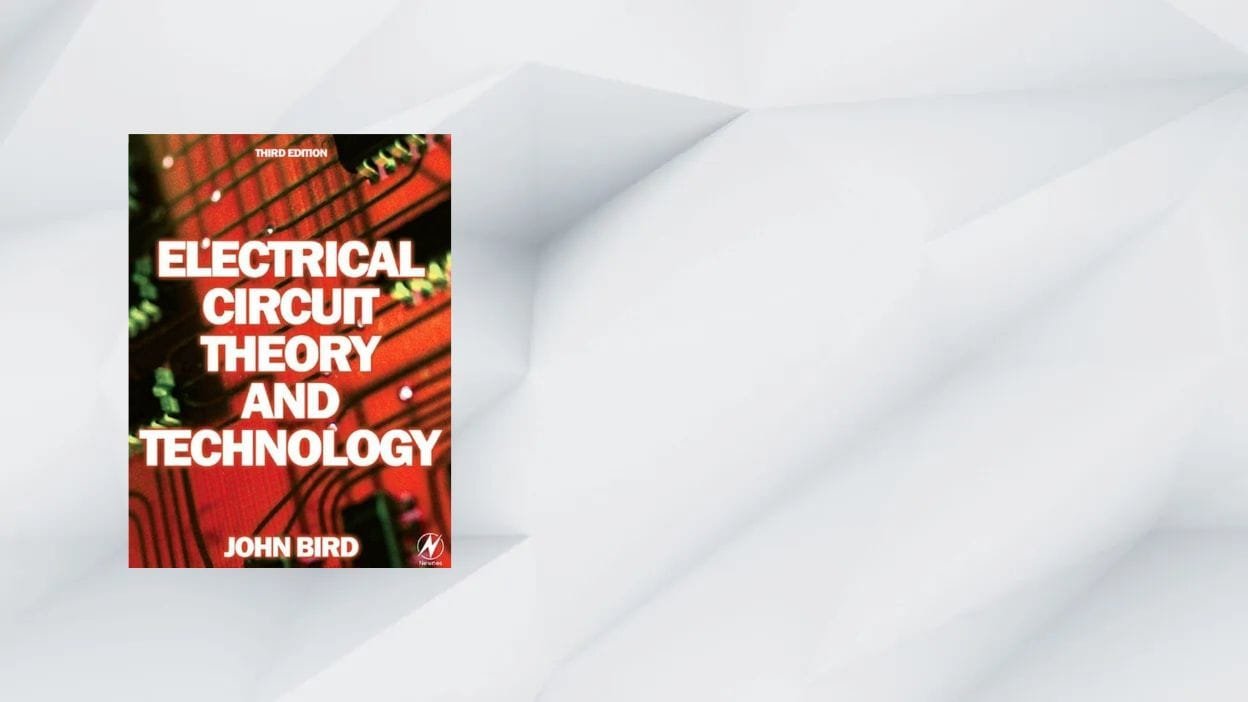John Bird’s Electrical Circuit Theory And Technology has long been a staple for first-year engineering programmes in the UK, India and beyond. The 3rd Edition (Newnes/Elsevier, 2007) stretches to almost 700 pages of clearly explained theory, 1 000+ worked examples and 1 800 end-of-chapter problems—making it one of the most practice-heavy circuit texts on the shelf.
Book at a Glance
| Title | Electrical Circuit Theory And Technology (3rd Edition) |
| Author | John Bird |
| Publisher / Year | Newnes / Elsevier • 2007 |
| Length | 692 pages (colour diagrams) |
| ISBN-13 | 978-0750681391 |
| Formats | Paperback • eBook (Routledge/T&F) |
| Typical Price | New ≈ US $245; used ≈ US $40–90 |
| Primary Audience | BEng/ BTech freshmen, HNC/HND & City-&-Guilds learners, self-taught makers |
Why the 3rd Edition Still Matters
- Theory-to-application bridge – Every concept flows from derivation → worked example → real-world tech (filters, motors, power factor).
- Problem-rich pedagogy – Over 1 000 solved examples plus 1 800 graded problems with answers build calculation speed and confidence.
- Modular design – Four self-contained parts (principles, circuit theory, electronics, reference) let tutors cherry-pick or flip the order without confusion.
- Exam alignment – End-of-chapter MCQs echo UK HND/HNC and City-&-Guilds exam formats, so revision feels familiar.
Chapter Highlights
| Part | Sample Chapters | Key Take-aways |
|---|---|---|
| 1 Electrical Principles | Units, DC circuits, magnetic circuits | Grounding in SI units + KCL/KVL basics |
| 2 Circuit Theory | AC fundamentals, complex numbers, resonance, 3-phase systems | Step-by-step phasor algebra & balanced-load analysis |
| 3 Electronics & Technology | Diodes, op-amps, digital logic intro | Bridges passive theory to active-device realities |
| 4 Reference Data | Wire-gauge tables, colour codes, maths recap | Instant lab or exam lookup |
Strengths
- Crystal-clear writing – Bird’s conversational tone and colour phasor diagrams slash intimidation levels.
- Worked-example density – Few texts match its ratio of examples to theory, perfect for “learn-by-doing” courses.
- Wide syllabus fit – Serves electrical, mechanical, marine and automotive programmes with equal ease.
Limitations
| Drawback | Impact | Quick Fix |
|---|---|---|
| 2007 vintage | No GaN/SiC devices, no SPICE/MATLAB demos | Pair with a modern power-electronics or simulation guide |
| UK symbol set | Uses IEC/BS graphics; NEC readers must translate | Keep a US-style schematic cheat-sheet nearby |
| Premium new price | Hard copy costs >$200 | Buy used or the lower-cost eBook edition |
How It Compares
| Feature | Bird 3e | Nilsson & Riedel 7e | Alexander & Sadiku 7e |
|---|---|---|---|
| Pages | ~700 | 992 | 1 456 |
| Worked examples | 1 000+ | 600+ | 800+ |
| End problems | 1 800 | 1 200 | 2 000 |
| Machines intro | ✔ | ✖ | ✖ |
| Best for | UK-style HND/BEng | US sophomore circuits | Deep analytical courses |
FAQ
Is Electrical Circuit Theory And Technology 3rd Edition beginner-friendly?
Yes—math peaks at basic calculus; Bird assumes only high-school algebra.
Are answers included?
Yes: odd-numbered problems have answers; a full solutions manual is available for lecturers.
Can I use it with SPICE?
Examples are hand-calculated, but transcribing them into LTspice or Multisim is straightforward and great practice.
Where can I buy it?
Amazon lists new and used copies (ISBN 978-0750681391); Routledge sells a lower-cost PDF eBook.

